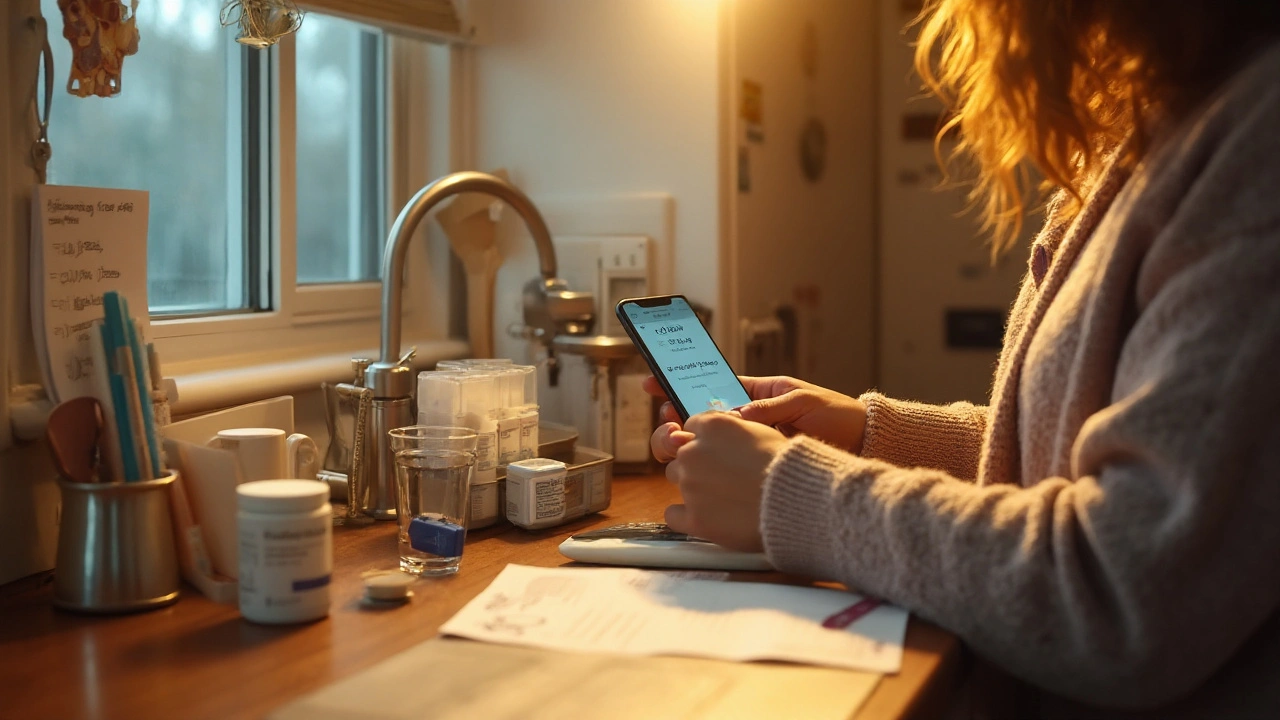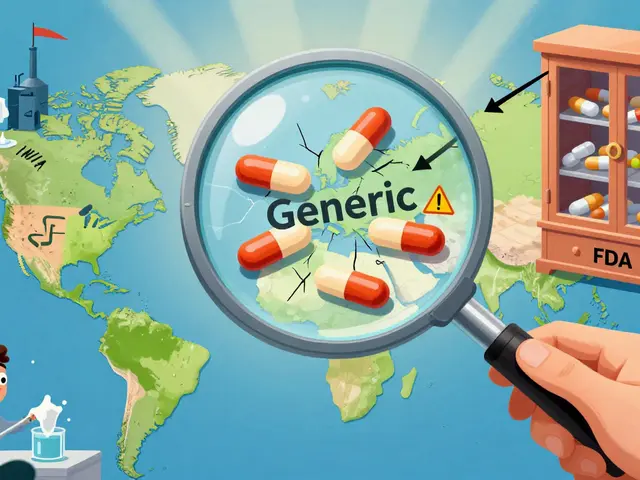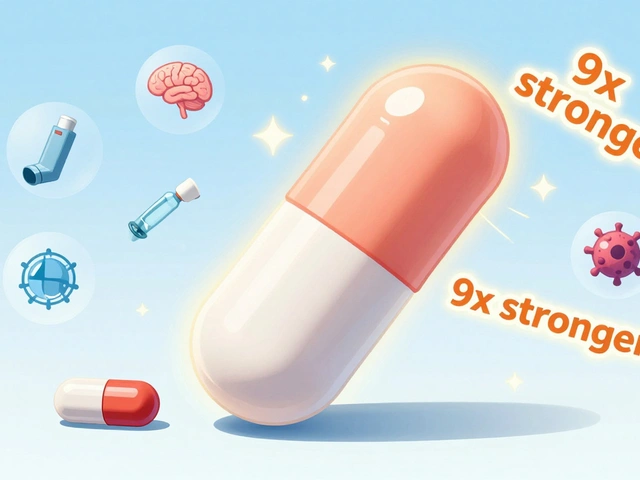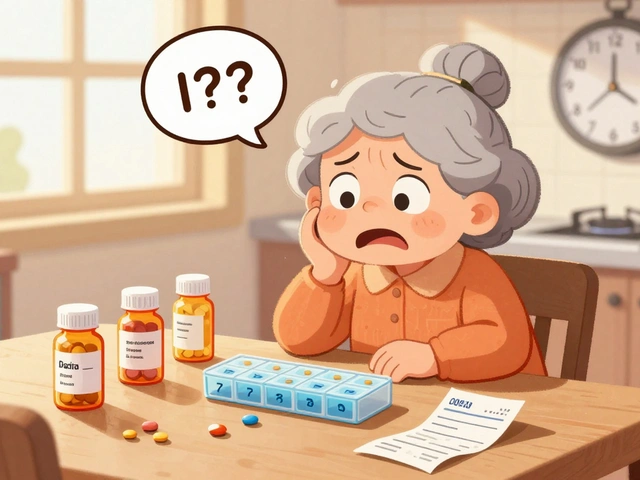Alpelisib Drug Interactions: What to Avoid, What’s Safe, and How to Manage

With alpelisib, one missed interaction can swing blood sugar, bump statin levels, or blunt cancer control. If you’re taking Piqray for HR+/HER2- breast cancer or Vijoice for PROS, you want simple rules you can follow and a short list of red flags you won’t forget. This guide breaks down the real-world issues: what to avoid, what’s safe, and how to set up monitoring so you catch problems early. No jargon, just clear steps.
- TL;DR
- Biggest risks: strong CYP3A4 inducers (can cut alpelisib levels), BCRP-mediated statin boosts (rosuvastatin), and blood sugar spikes with steroids or high-risk meds.
- Take alpelisib with food every time; this reduces stomach-acid issues and keeps levels steadier.
- Switch off rifampin/carbamazepine/phenytoin/St John’s wort before starting; choose statins like pravastatin (or lower rosuvastatin with CK checks).
- Expect hyperglycemia; have a plan (often metformin first line, add-ons if needed). Monitor glucose closely for the first 8 weeks.
- Warfarin users: check INR more often; alpelisib can change CYP2C9 substrate exposure.
What drives alpelisib interactions (and why they matter)
You don’t need to memorize enzyme maps to stay safe, but a few facts go a long way. Alpelisib (brand names Piqray and Vijoice) is an oral PI3Kα inhibitor. It’s taken with food, once daily. Most of its metabolism isn’t through a single classic liver pathway, but some transporters and enzymes still matter. Here are the anchors you can trust.
- Strong enzyme inducers are the main threat. Drugs that strongly induce CYP3A (and often P-gp and other pathways) can lower alpelisib exposure enough to matter clinically. Think rifampin, carbamazepine, phenytoin, phenobarbital, and St John’s wort. If left in place, they can undercut efficacy.
- Strong enzyme inhibitors are less of an issue for alpelisib. The FDA and EMA labels report no clinically meaningful rise in alpelisib levels with potent CYP3A inhibitors when alpelisib is taken with food. So ketoconazole or ritonavir aren’t the same kind of problem here as they are with some TKIs.
- Transporter effects are real-especially BCRP. Alpelisib can increase exposure of intestinal BCRP substrates. The classic example is rosuvastatin. When you see rosuvastatin on the med list, plan to monitor or switch to a safer statin.
- Stomach acid medicines aren’t the main story-food is. Alpelisib has pH-dependent solubility in the fasting state, but the labels emphasize taking it with food, which blunts the acid-suppression effect. In short: stick to food; you usually don’t need to juggle your PPI timing.
- CYP2C9 substrates can be affected. Alpelisib can alter exposure of CYP2C9 substrates in a way that matters for narrow-index drugs like warfarin. Pair that with more frequent INR checks until you see the new steady state.
- Pharmacodynamic interactions matter just as much. Alpelisib often raises blood glucose. Steroids, atypical antipsychotics (like olanzapine), thiazide diuretics, niacin, and high-dose beta-agonists can push sugars even higher. Plan for that.
Those points come straight out of primary sources: the FDA Prescribing Information for Piqray (alpelisib), the FDA Prescribing Information for Vijoice (alpelisib), and the EMA SmPC. For glucose management strategy in PI3K inhibitors, oncology groups like ASCO and ESMO have published practical approaches your team may follow.
Step-by-step: clear workflow to screen and manage interactions
Here’s a simple path that works in clinic and at home. This is the checklist I wish everyone had on day one.
- Before the first dose: clean the med list.
- Collect prescriptions, OTCs, herbals, and supplements. Ask specifically about: seizure meds, antibiotics, mood stabilizers, sleep/nerve meds, pain meds, heart/cholesterol pills, and any “natural” products for stress or sleep.
- Scan for strong CYP3A inducers: rifampin/rifabutin, carbamazepine, phenytoin, phenobarbital, primidone, St John’s wort. If present, plan a switch or taper before alpelisib starts. Document any washout period your prescriber recommends.
- Check statin choice. Rosuvastatin is a BCRP substrate; consider pravastatin or a lower-dose rosuvastatin with CK monitoring. Atorvastatin can be an alternative depending on goals and comorbidities.
- Note warfarin (or narrow-index CYP2C9 substrates). Set up more frequent INR checks for the first few weeks.
- Review diabetes status. Get a fasting glucose and HbA1c. If prediabetic or diabetic, line up a glucose plan (usually metformin first, unless contraindicated). Agree on thresholds for escalation.
- Lock in administration rules.
- Take alpelisib with food at the same time every day. Food is not optional; it steadies levels and eases stomach-acid concerns.
- Swallow tablets whole. No crushing, splitting, or chewing.
- If you also take a PPI, H2 blocker, or antacid, you don’t need to space them out if you’re taking alpelisib with food. Just be consistent with the meal.
- Plan glucose monitoring and rescue.
- Home checks: daily fasting glucose for the first 2 weeks, then at least twice weekly through week 8. After that, follow your team’s plan.
- Have metformin on hand if your team recommends it upfront, or be ready to start it quickly if fasting glucose rises above the agreed threshold.
- If already diabetic, confirm an action plan: when to add a second agent (e.g., an SGLT2 inhibitor, DPP-4 inhibitor, GLP-1 receptor agonist), when to call the clinic, and what to do if you’re ill or not eating much.
- Map the early lab schedule.
- Glucose: frequent early checks (home + clinic). HbA1c every 3 months if relevant.
- INR: if on warfarin, check more often for the first 2-3 weeks, then space as stable.
- Lipids: alpelisib can raise triglycerides; get a baseline and repeat as advised.
- Kidney function and electrolytes: useful if ramping up diabetes meds.
- Educate on boosters and breakers.
- Boosters (increase glucose): steroids (oral, IV; topical is usually fine), atypical antipsychotics, thiazides, niacin. If you must use them, preemptively tighten glucose checks and meds.
- Breakers (reduce alpelisib levels): the strong inducers list; avoid or switch.
- Potential amplifiers of other drugs: BCRP substrate statins (rosuvastatin). Monitor and adjust.

Common interaction scenarios and the fixes
If you like concrete examples, this is the meat. Below are the interactions you’re most likely to see in 2025, what happens, and what to do.
| Drug/class | What can happen | What to do |
|---|---|---|
| Rifampin, rifabutin (strong inducers) | Alpelisib exposure can drop, risking reduced cancer control. | Avoid; switch to a non-inducing alternative if possible before starting alpelisib. |
| Carbamazepine, phenytoin, phenobarbital, primidone (strong inducers) | Same as above-levels fall. | Neurology/oncology coordinate a safer regimen; document washout plan. |
| St John’s wort (herbal inducer) | Lowers alpelisib exposure. | Stop; don’t restart while on alpelisib. |
| Strong CYP3A inhibitors (ketoconazole, clarithromycin, ritonavir) | Minimal change in alpelisib when taken with food. | No routine dose change for alpelisib; check the other drug’s label for its own interactions. |
| PPIs/H2 blockers/antacids | Fasting exposure can drop, but with food the effect is small. | Take alpelisib with food; no spacing needed in most cases. |
| Rosuvastatin (BCRP substrate) | Statin levels can rise (higher myopathy risk). | Use lowest effective dose, check CK if symptomatic, or switch to pravastatin/atorvastatin. |
| Warfarin (CYP2C9 substrate) | Alpelisib can change warfarin exposure; INR can shift. | Increase INR checks during start and any dose changes; adjust warfarin as needed. |
| Steroids (prednisone, dexamethasone) | Raise glucose; can turn mild hyperglycemia into severe. | Use only if needed; intensify glucose monitoring and adjust diabetes meds proactively. |
| Atypical antipsychotics (olanzapine), thiazides, niacin | Raise glucose. | Reassess the need and dose; bolster glucose plan if continued. |
| Antidiabetics (metformin, SGLT2i, DPP-4, GLP-1) | Pharmacodynamic balancing act; no major PK clash expected with alpelisib. | Metformin is usual first step; add agents per glucose targets and comorbidities. |
| Fulvestrant (given with Piqray in HR+/HER2- BC) | No clinically meaningful PK interaction reported. | Standard co-use per label; still screen the full med list for each drug separately. |
Notes you can rely on:
- Always take alpelisib with food. This single habit simplifies a lot of nonsense with acid reducers and smooths out variability.
- If a strong inducer is absolutely unavoidable, involve oncology/pharmacy early; this is not a “watch and wait” situation.
- Statin question? If the patient is on rosuvastatin and needs to stay on it, use the lowest effective dose and symptom-triggered CK labs. If you can switch, pravastatin or a tailored atorvastatin dose is often simpler.
- Warfarin is safer with more INR checks rather than assumptions; let the numbers guide you.
Side note on supplements: apart from St John’s wort, the risk is more about the unknown. Turmeric, berberine, and “metabolism boosters” can carry enzyme/transporter effects that aren’t well studied alongside alpelisib. If it’s not essential, skip it during therapy.
Checklists, quick rules, and FAQs you’ll actually use
Bookmark this bit. It’s the day-to-day cheat sheet, a mini-FAQ, and what to do next if things veer off plan.
10-second triage for alpelisib drug interactions:
- Scan for strong inducers: rifampin, carbamazepine, phenytoin, phenobarbital, St John’s wort. If yes → switch/stop before alpelisib.
- Statin? If rosuvastatin → consider pravastatin or use lower dose + CK monitoring.
- Warfarin? Yes → schedule more INR checks for 2-3 weeks.
- Diabetes meds? Yes/no → set a glucose plan either way; have metformin ready if appropriate.
- PPIs/H2? Fine if alpelisib is taken with food; no special spacing.
Simple rules of thumb:
- Food every time. Same time daily. Don’t skip meals with your dose.
- Don’t start or stop meds without telling your oncology team. Even “just an antibiotic” can be an inducer.
- If a new steroid course pops up (sinusitis, back pain), treat glucose like a high alert for the next week.
- Keep a pocket list (phone note) of your key meds so urgent care can check before prescribing.
Quick decision helps:
- Statin needed and high intensity required? Discuss atorvastatin or pitavastatin instead of high-dose rosuvastatin.
- Antibiotic choice in a pinch? Azithromycin or amoxicillin-clavulanate usually sidestep the inducer issue; rifamycins do not.
- SGLT2 inhibitor as an add-on for glucose? Useful, but educate on sick-day rules and ketoacidosis symptoms, especially if appetite is low.
Mini-FAQ
- Do I need to avoid grapefruit? The alpelisib labels don’t flag a meaningful issue with CYP3A inhibitors when taken with food. Many clinics still give a blanket “avoid grapefruit” rule for oral oncolytics. Follow your team’s advice; if you do have grapefruit, keep it modest and consistent.
- Can I take antacids or a PPI? Yes-if you’re taking alpelisib with food, acid reducers haven’t shown a clinically important impact. No need to separate doses.
- What about pain meds? Most are fine. Watch for chronic NSAID use in patients on warfarin (bleeding risk). Opioids have no direct clash with alpelisib.
- Are there issues with blood thinners like apixaban/rivaroxaban? Not typically with alpelisib. The bigger anticoagulant watch is warfarin (CYP2C9). Still, always re-check the DOAC’s own interaction profile.
- Alcohol? Light to moderate intake is usually fine, but heavy drinking can push glucose up and isn’t friendly to pancreatitis risk. If sugars run high, scale back.
- Vaccines? No direct interaction. Keep routine vaccines on schedule unless your team advises a different plan.
Next steps and troubleshooting
- If fasting glucose hits 10-13 mmol/L (180-235 mg/dL) repeatedly in the first two weeks: call your team. Expect metformin start/titration if not already on it, and possibly a second agent. Don’t wait for a clinic day.
- If you start a steroid pack: double your glucose checks (fasting + one evening), hydrate, and alert the clinic if readings jump.
- If muscle pain shows up on rosuvastatin: pause heavy exercise, get a CK level, consider a switch to pravastatin/atorvastatin.
- If INR suddenly drifts on warfarin: tell your anticoagulation clinic you’re on alpelisib so they factor it into the dose algorithm.
- If you must use an inducer short-term (rare, but it happens): involve oncology/pharmacy; ask whether to hold alpelisib or change the inducer. Don’t make that call solo.
Documentation that backs this up
Primary, authoritative sources include: the U.S. FDA Prescribing Information for Piqray (alpelisib) and Vijoice (alpelisib), and the EMA Summary of Product Characteristics for alpelisib. These documents outline the effects of strong CYP3A inducers, the minimal impact of CYP3A inhibitors when taken with food, the interaction with BCRP substrates like rosuvastatin, the guidance on taking with food, and the need to monitor and manage hyperglycemia. For managing PI3K inhibitor-related hyperglycemia, oncology society guidance (ASCO/ESMO supportive care recommendations) gives practical escalation steps that many clinics adopt.
Bottom line you can act on today: avoid strong inducers, take alpelisib with food, pick statins carefully, check INR if on warfarin, and treat glucose like a priority signal for the first two months. Do those five things well, and you’ll dodge most of the meaningful interactions with alpelisib.
10 Comments
Shelley Beneteau
I appreciate the clear checklist; it gives me a quick reference when reviewing my medication list. It’s reassuring to see the emphasis on food intake and monitoring.
Sonya Postnikova
Thanks for breaking it down so nicely – this is exactly the kind of practical guide we need when juggling so many pills 😊. The food‑with‑alpelisib tip alone will save a lot of head‑scratching.
Anna Zawierucha
Oh great, another “just take it with food” saga – because we all love culinary instructions for cancer meds.
Mary Akerstrom
This is super helpful for anyone starting alpelisib. The step‑by‑step format makes it easy to follow. I like how it stresses checking the whole med list up front. The reminder to monitor glucose early is especially important. It also clears up the confusion about PPIs – no need to time them separately. Having a clear plan for statin choice removes a lot of guesswork. The INR advice for warfarin users is spot on. Overall, a solid, patient‑friendly resource.
Delilah Allen
Honestly, the whole “avoid strong inducers” rule feels like a never‑ending list, but okay, we’ll keep a spreadsheet, double‑check every prescription, and pray the pharmacy doesn’t miss something, because the stakes are high, and I’m not about to let a hidden rifampin ruin my treatment.
Nancy Lee Bush
Wow, this guide really pulls together everything we’ve been scrambling to figure out, and I’m impressed by how thorough it is, especially given how complex alpelisib can get, so let me unpack a few key points, first the food rule – taking it with a meal isn’t just a convenience, it actually stabilizes absorption, which means fewer peaks and troughs in drug levels, and that translates to more consistent tumor control, second the inducer list – rifampin, carbamazepine, phenytoin, phenobarbital, St John’s Wort, these are the real deal breakers, you really need to switch them out before starting alpelisib, otherwise you risk sub‑therapeutic exposure, third the statin situation – rosuvastatin is a BCRP substrate, so it can balloon, causing muscle pain or even rhabdomyolysis, a safer bet is pravastatin or a low‑dose rosuvastatin with CK monitoring, fourth the warfarin interaction – alpelisib can tweak CYP2C9 activity, so more frequent INR checks are a must during the first weeks, and finally the glucose spike – steroids, thiazides, atypical antipsychotics can really push sugars up, so having metformin ready and a clear escalation plan is critical, I also love the practical tables, they make it easy to scan for red flags, and the “quick triage” list at the end is gold for busy clinicians, remember to keep a pocket note of your key meds so if you end up in the ER they have the info right away, and if you ever need an antibiotic, think amoxicillin‑clavulanate or azithromycin instead of rifamycins, that will keep the alpelisib levels stable, overall this cheat sheet is a lifesaver for patients and providers alike, thanks for putting it together! 😊
Dan Worona
While most people will just follow the pamphlet, I can’t help but wonder who’s really benefitting from pushing these interactions onto us. Every time a new drug hits the market, there’s a hidden agenda to keep us dependent on pharma‑driven monitoring programs. The “just take it with food” line feels like a control tactic – they know we’ll miss a meal, cause variability, and then blame us for poor outcomes. It’s all part of the larger scheme to keep the entire healthcare ecosystem in a perpetual state of vigilance, which translates into more appointments, more labs, more revenue. Keep your eyes open, folks.
Chuck Bradshaw
Actually, Dan, the data doesn’t support a conspiracy here. The food recommendation is based on pharmacokinetic studies showing reduced variability, not a profit motive. The interaction list comes from FDA‑mandated labeling, which is meant to protect patients, not to create extra work. While it can feel burdensome, the goal is safety.
Howard Mcintosh
Yo, this is super helpful – love the vibe. One thing I’d add is to double‑check dosing units, sometimes they typo mg vs mcg and that can mess you up. Also, keep an eye on your own stress levels, they can affect glucose too. Stay strong!
Jeremy Laporte
Great point, Howard! Stress does play a role, and a quick reminder to take deep breaths before checking glucose can actually help keep numbers steadier. Keep sharing these practical tips!






Write a comment